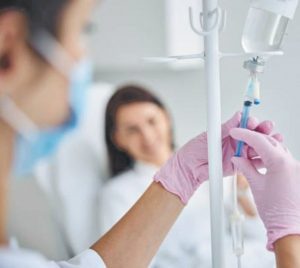

First, the intravenous routes provide for 100% bioavailability. What this means is that 100% of the dose is going to end up where it needs to work (the brain). This makes it easy to titrate to effect. If a patient doesn’t respond to Ketamine 50 mg then the dose may be increased knowing that the dose at which a patient does respond, is precisely that dose. As with most medications, the lowest effective dose is what we are looking for in order to minimize adverse responses and complications. Ketamine lozenges and nasal sprays do not provide 100 % bioavailability. At a given dose, 3 different patients will absorb a 50 mg dose to varying degrees. This makes it very difficult to determine the actual amount of Ketamine a patient is responding to.
Further, many of the patients we see at our Center have experienced significant trauma at points in their lives. These patients are wary of having a significant dissociative experience which may bring them back to terrifying times in their lives. It is easier to control the dissociative experience with intravenous Ketamine than with the other routes of administration. What we have seen and what the science has shown to date, is that one doesn’t have to have significant dissociation to reap the benefits of Ketamine therapy. It is the actual physical changes that Ketamine ignites through a cascade of biochemical pathways which is thought to be responsible for these positive responses. Using IV ketamine, in a monitored setting with a physician present, it is relatively easy to control the rate of Ketamine administered making sure that a patient tolerates the treatment throughout. This is done by adjusting the rate, administering medications to help patients tolerate the infusion if necessary and, in some cases, stopping the infusion for a short time to let the medication wear off until a patient is feeling more comfortable.
There are numerous studies going on presently using substances such as psilocybin, MDMA, DMT etc. to determine potential benefits in helping patients diagnosed with MDD, anxiety disorders, PTSD, and substance abuse disorders. These studies are incorporating concurrent therapy while the patient undergoes the experience. To date, use of these substances potentially may be of great value down the road. While it may ultimately be proven that these substances work similarly to Ketamine with respect to the physical changes in the brain known to occur with Ketamine, this is not yet proven. Also, There are no studies to date showing efficacy of concurrent psychotherapy during IV Ketamine infusion. In fact, most of our patients prefer to listen to music or “zone out” in their thoughts during the course of an infusion, preferring not to talk. By the same token, I feel strongly that patients continue or begin talk therapy during and after the course of treatment with Ketamine to maximize the improvements and sustain the response following treatment.
For these reasons, I believe that patients struggling with difficult to treat mood disorders who decide to try Ketamine should strongly consider the “gold standard” of treatment which are Ketamine infusions. This will allow for determining whether a patient will respond in the most precise, effective and safe manner.
Gulf Coast Ketamine Center
Gulf Coast Ketamine Center works closely with a therapist well-versed in Ketamine therapy to maximize the benefits of the therapy in patients who are appropriate for this particular treatment.
The uses of IV Ketamine keep expanding as far as the mental health field is concerned; selecting a practitioner with a significant amount of Ketamine experience who follows and practices evidence-based medicine, and who tailors each patient’s individual protocol as best suited to their clinical situation is essential.
Dr. Steven Reichbach states, “In our opinion, IV Ketamine infusions are the gold standard for patients with severe mood disorders or those suffering from chronic pain. It is now purported as viable option for those that suffer from addictions as well.
“IV ketamine provides 100% bioavailability meaning that 100% of the drug administered, gets where it needs to go (the brain). This provides easier titration and a higher likelihood for a positive response. At the end of the day, the out of pocket cost to the patient may be more than the IV infusions depending on an individual’s insurance coverage, not to mention the time convenience advantage for the patient of the IV ketamine infusions.”
Steven Reichbach, MD, Board-Certified Anesthesiologist, specializes in pain management. For more information, please contact their office today at 941-213-4444, or visit their website at findpainrelief.com.
Steven Reichbach, MD
Board-Certified Anesthesiologist
President and Founder,
Gulf Coast Ketamine Center
Lolita Borges, RN
Clinical Director, Gulf Coast
Ketamine Center
Gulf Coast
Ketamine Center
2415 University Parkway, Building #3,
Suite 215, Sarasota, FL 34243
941-213-4444 | findpainrelief.com
 Southwest Florida's Health and Wellness Magazine Health and Wellness Articles
Southwest Florida's Health and Wellness Magazine Health and Wellness Articles

